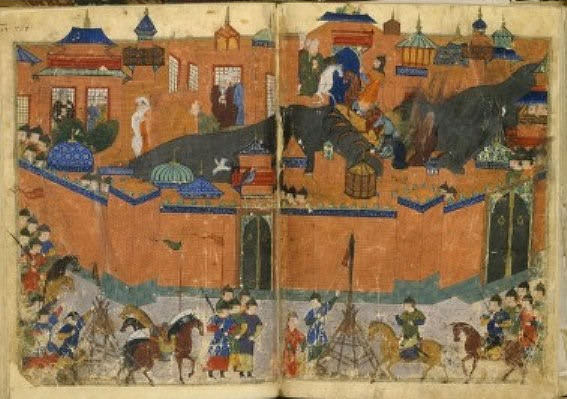Source: Medievalists.net June 25, 2012
By Matthew Barnes
Publications in Contemporary Affairs (2009)
Introduction: In the early 13th century a young Mongol chieftain called Temujin united the nomadic steppe peoples of Mongolia through conquest in order to fulfill his vision of a great nation. When Temujin became the undisputed leader of the steppes, he took on the infamous name of Genghis Khan. What followed were some of the most dazzling military campaigns of the ancient world, military achievements which are still often overlooked today. In the Western narrative of military history much emphasis is put on the campaigns and successes of Julius Caesar, of Alexander the Great, Richard the Lion Heart, the Carolingians, the Vikings and many other martial peoples and great leaders. However, Genghis Khan and his successors went on to conquer lands from the Pacific to the Black Sea and from India to the Aegean. Storming out of Asia after crippling parts of Northern China, the Mongols cut swathes across Eastern Europe and Russia, burning Kiev, Moscow and Cracow to the ground as well as ravaging Hungary, Romania, Bulgaria, Siberia and many other regions during their great Western expedition. The Mongol warriors faced other nomads, European knights, troops behind massive stone walls, Korean guerillas, Burmese war elephants and even the famed Japanese Samurai. Ultimately, the Mongols’ mastery of the battlefield allowed them to rule over the largest contiguous land empire in the history of the known world. Naturally, there are many contributing factors which allowed the Mongol armies to ascend to such great heights and these range from ingenious leadership, to discipline and tactics as well as their strategies and especially the inherent qualities of the steppe people as a trained reservoir of warriors.
Historian Steven Turnbull said that the ‘Mongol warrior was one of the great success stories of world military history,’ and certainly the world shook in fear of them whilst the ground trembled beneath their feet as they conquered nearly half the world’s land in a series of stunning campaigns. The Mongols took on an almost mythical quality, but their success is grounded in very real factors. Mongol historian C.C. Walker sums up the military achievements of the Mongols aptly when he says:
There are lesser Mongol chiefs who rode farther, crossed higher mountains and fought several battles which were of equal or greater scope than those of Hannibal at Cannae. Hannibal’s maneuver – to give way in the centre, draw in the main body of the attacker, then crush him with his flanking cavalry – was an oft-repeated tactic employed by the Mongols in all their campaigns across Eurasia. Alexander fought fewer enemies and battles and stormed fewer cities than Subotai [a Mongol general] during the expedition from Manchuria to the Crimea. The Mongol cavalry achieved some its greatest achievements in the snows of Russia which crushed Napoleon.
The first step in the Mongol road to immortality was the forging of many different peoples into a highly organized and cohesive fighting force commanded by loyal leaders who would ride to the ends of the world if their leader ordered it. As such, this paper will first deal with the natural qualities of the Mongols which were capitalized upon in order to turn a wild rabble into a ferocious army that could appear anywhere at any time, before moving on to their training, their leadership, their tactics and their strategies which led them to victory time and time again.

No comments:
Post a Comment